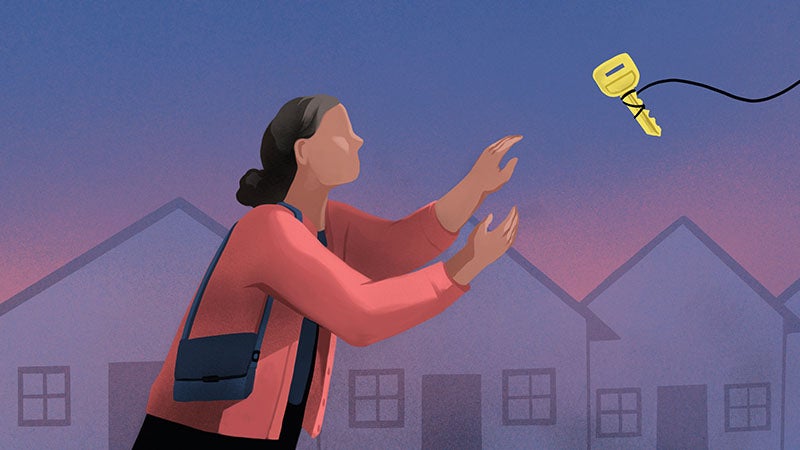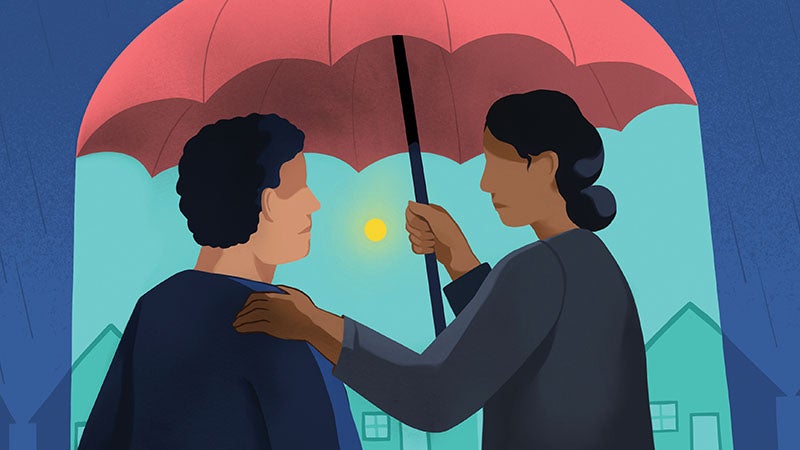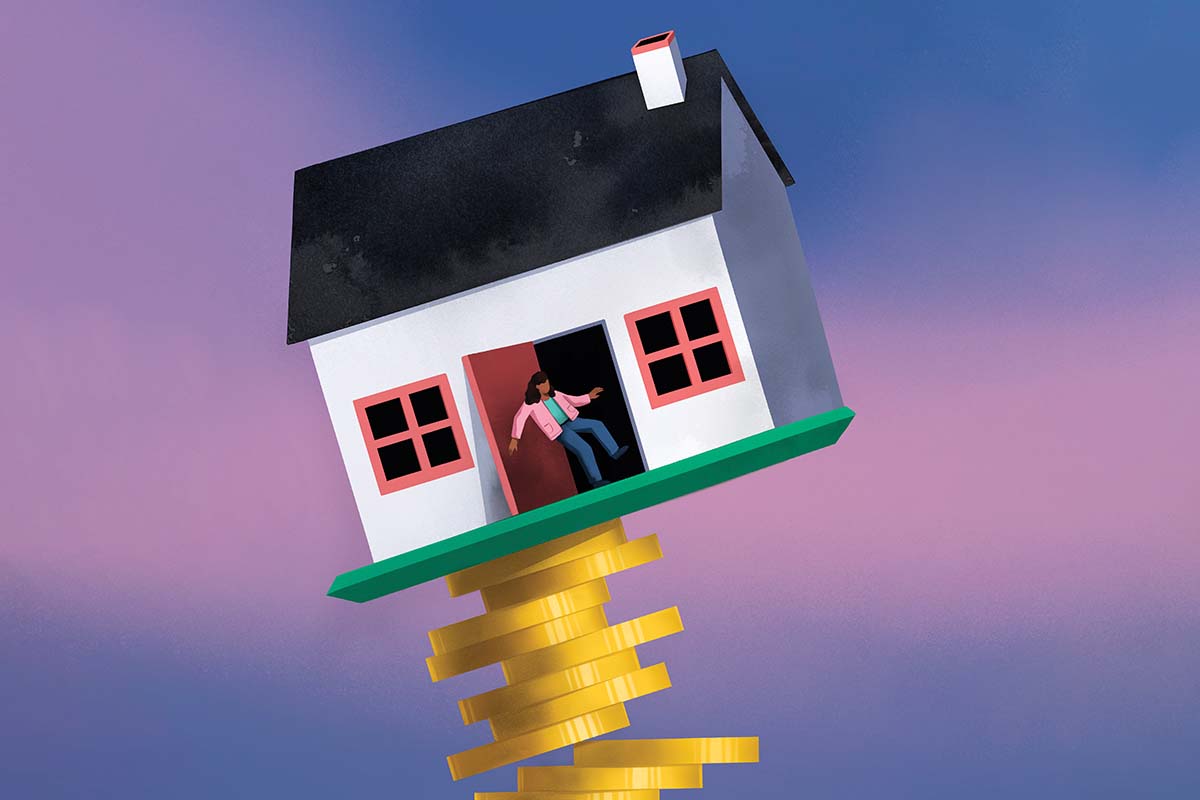
It was a hot and humid day in Orlando when a 72-year-old woman showed up at SALT (Service and Love Together) Outreach looking for help.
Her face was flushed red from the sweltering weather and it seemed like she could be suffering from heat exhaustion. She was thirsty and overwhelmed, and she didn’t know where to go.
She’d just lost her home because her rent had increased and she couldn’t afford the higher rate. Her husband had recently passed away and, without his financial contribution to their bills, she was struggling to make ends meet. She couldn’t work and didn’t have a way to bring in more money to cover rent, so she started sleeping on the streets with her dog.
“Our team worked tirelessly to find a temporary place for her, but there were no shelter beds,” says Eric Camarillo ’16 ’19MNM, founder of SALT Outreach, a nonprofit that supports unsheltered people in Central Florida and helps them find ways to end their homelessness. “We had to coach her on how to survive while sleeping on the sidewalk in Parramore because there was just no other option for her,” Camarillo says.
This story is increasingly common in Central Florida.
The homeless population is surging and many people, including a record number of seniors, are experiencing homelessness for the first time. Shelters and resources can’t keep pace with the growing number of homeless individuals, so many end up on the streets.
“We’re seeing seniors, domestic violence victims, veterans, teenagers who escaped human trafficking, families with young children, moms that give birth in the hospital and, in a few days, they’re out on the street with their newborn baby,” Camarillo says. “Every situation’s so different, but the bottom line is that there isn’t enough affordable housing, shelter space or permanent supportive housing right now.”
The number of homeless people counted across Orange, Osceola and Seminole counties reached 2,883 in 2024, a 28% increase from 2023. And the number of homeless individuals who don’t have shelter of any kind more than doubled, from 587 people to nearly 1,200. This data was collected as part of an annual nationwide effort to track the number of homeless individuals for a federally mandated census called a Point-in-Time (PIT) count.
As the homeless population continues to swell, UCF experts and alumni are investigating the factors that contribute to this issue and considering how to help more people find their way home.
“Every situation’s so different, but the bottom line is that there isn’t enough affordable housing, shelter space or permanent supportive housing right now.”
Getting Squeezed Out of Housing
“The number one cause of homelessness across the nation is the lack of affordable housing,” says Andrew Sullivan, an assistant professor in the School of Public Administration and the director of the Center for Public and Nonprofit Management, whose research focuses on homelessness, homeless services and collaborative governance.
Florida has seen a massive population boom since the COVID-19 pandemic hit, he says, with over 130,000 new people living in the Orlando metro area alone, according to the U.S. Census Bureau. This population spike has contributed to a swift hike in housing costs and a soaring demand for a limited supply of housing.
“People who could buy homes even a few years ago aren’t buying them now because the costs are too high,” says Amy Donley ’02 ’04MA ’08PhD, a graduate of and associate professor in UCF’s sociology department, and director of the Institute for Social and Behavioral Science. Donley also serves on the board of directors for the Coalition for the Homeless of Central Florida.
Seniors and other homeowners can’t downsize, she says, because it’s cheaper to stay in their current homes. This prevents starter homes from making it to the market for first-time homebuyers and keeps the rental market tight — so tight that it keeps squeezing people out.
Orlando consistently ranks among the worst places in the nation for affordable housing. In 2024, the city saw the fourth-highest shortage of affordable housing in the U.S., according to the National Low Income Housing Coalition (NLIHC), meaning the region lacks housing available for 30% of someone’s gross income or less, including utilities.
And the job market isn’t helping the situation.
“Our wages don’t compete with the housing prices, so we’re trapped in a cycle where the inventory just doesn’t support the need,” says Amber Carroll ’00, executive director of the Brevard Homeless Coalition and treasurer of the Florida Coalition to End Homelessness.
In Florida, the average rent for a fair market one-bedroom home is $1,525 a month. At the state’s current minimum wage of $12 an hour, workers would have to log 98 hours a week to afford a similarly priced home.
Zillow data suggests it’s even worse in Central Florida. With an average two-bedroom going for $2,100 a month, Donley says people would need to make nearly $30 an hour to afford such a home in Orlando.
The NLIHC estimates that Florida needs over 435,000 more affordable and available rental homes to meet the needs of lower-income residents, who account for a significant chunk of the state’s population. Around 1 in 5 renters in Florida are at or below the poverty line or only making around 30% of the median income in their area.
This challenging combination of unaffordable housing and low wages means an increasing number of people are falling behind on bills and struggling with their rent.
“So many people are living just at the edge and a few hundred dollars a month can make the difference between being able to keep your house or losing it,” Donley says.
As more people get pushed over the financial brink, many are experiencing homelessness for the first time — and it’s happening across all population groups.

Homelessness Is Hitting Every Demographic
Donley was leaving an event on Walt Disney World Resort property earlier this year when she saw a homeless man standing outside the resort gate.
“So many people are living just at the edge and a few hundred dollars a month can make the difference between being able to keep your house or losing it.”
“That was a first for me,” she says. “I’ve lived in Central Florida for around 25 years and there’s been a very noticeable increase in people experiencing homelessness in new places and neighborhoods, which just shows how the lack of housing is affecting every community and population in our region.”
The most recent PIT count found that 718 unhoused people were over the age of 55, and 195 were over the age of 64. This population is especially vulnerable while unsheltered, Camarillo says, as they’re more susceptible to added challenges and health issues from Florida’s heat and hurricane activity. SALT Outreach tries to equip people with ponchos, flashlights and information before major storms, but many people still lose everything when an especially destructive hurricane hits.
Young people also account for a troubling chunk of the homeless population, which includes a growing number of college students who are getting pushed out of the competitive housing market.
Reneé Trincanello ’99, CEO of Covenant House Florida, says some of the caseworkers at her organization report that students make up half of their caseload. Covenant House is a resource center for homeless youth, with a shelter in Fort Lauderdale, Florida.
“There’s over 4 million young people in the age group of ‘youth,’ which we consider 16 to 24, that are homeless nationwide,” Trincanello says. “And we’re seeing that exact same kind of pattern occurring in Florida.”
The factors that lead to homelessness for young individuals can be more complicated than just the cost of housing, Trincanello says. Homeless youth have usually been failed by a cross-section of systemic issues and are more affected by personal, social and environmental factors than health and well-being. She also stresses that many of the young people her organization serves have been subject to trauma, abuse and neglect.
“A lot of people think there’s a magic day when you turn 18, and you should have all of these systems in place for you as an adult,” she says. “But a lot of the young people that we serve haven’t had access to the right resources from a very young age, whether that’s medical resources, food security, education, employment or safe housing.”
Out of Options With Nowhere to Go
While the homeless population is growing, the number of shelter beds is dwindling and insufficient.
There are just 1,100 shelter beds in the region and they’re reliably full every night, Camarillo says. Covenant House was forced to shutter its youth shelter in Orlando last summer due to a funding shortage and has struggled to find a location for a new facility.
The number of beds isn’t the only issue with connecting homeless people with shelter.
Donley conducted a study about why people opt out of homeless shelters and found that there are many reasons people choose to sleep unsheltered instead. Most shelters don’t allow pets. Some married couples avoid shelters because they can’t stay together. Some communities can feel unsafe. And veterans with post-traumatic stress disorder can feel triggered by the shelter environment.
The lack of shelter beds in Central Florida will also present a challenge for a new law that went into effect on Oct. 1. HB 1365, also known as the “Unauthorized Public Camping and Public Sleeping” bill, prohibits individuals from sleeping in public spaces, like city parks, sidewalks and benches. It also gives people the right to sue businesses and government agencies that don’t enforce the ban.
The law requires local governments to supply shelter as an alternative if they need to relocate someone sleeping in a public space. But due to the shortage of shelter beds in Central Florida, there’s not much shelter to supply. Some local leaders are concerned about the ramifications of this law and are worried that homeless individuals will instead get arrested when law enforcement has to respond.
Some people are hopeful that the new law will lead to a funding increase for support services and shelter beds, but funding isn’t the only barrier to actually helping the homeless population get the shelter they need.
Many efforts to increase shelter space in the region have faced community resistance. There’s often a “not in my backyard” sentiment when it comes to developing facilities to serve the homeless, Trincanello says.
It doesn’t help that many Americans have a certain belief about what homelessness looks like, she says, and it’s often not aligned with reality.
“When people think of a displaced or homeless person, they’re often envisioning a chronically homeless individual that might be at a bus stop or walking in traffic or on the side of the road and that’s not the people that we’re working with every day,” Trincanello says. “The young people we meet have so much potential, talent and intelligence, and just need solid, consistent services and a safe place to be able to soar.”
She says she believes raising awareness about the homeless experience and the humans living it can bridge the gap between talk and action.
“Awareness and advocacy could help build support for the systems, infrastructure, legislation and policy that actually make a difference,” Trincanello says. “We need people to not just listen and empathize, but actually say yes to services that are going to strengthen the community instead of being fearful of them.”
It All Comes Back to Housing
The experts agree: housing is at the core of the problem, and it needs to be at the core of the solution.
“We wouldn’t have such widespread homelessness if we had enough housing,” Donley says.
While there’s often rhetoric about how mental health services are the solution to homelessness, there’s a reason those services don’t move the needle.
“Mental health isn’t the main cause of homelessness,” Sullivan says. “It’s the cost of housing and the ability to pay for housing.”
The vast majority of homelessness is related to an income shock or financial stress, Sullivan says, like a medical bill, car accident or job loss. “The most effective way to help these people is cash assistance to prevent homelessness from happening in the first place,” he says. He explains that helping someone cover a few bills in the short-term is much easier and cheaper than trying to find someone a new home after they’ve become homeless, as that often involves a deposit, multiple months of rent and reference checks.
While homeless prevention programs are effective, there’s more demand than cash available to meet the need. That’s a common thread across most homeless resources and services. Donley says the Coalition for the Homeless of Central Florida had to close its list for permanent supportive housing because there were too many qualified people and no housing stock left for them. Insufficient funding also remains one of the greatest challenges for the Brevard Homeless Coalition, which works with organizations to provide transitional housing and permanent supportive housing in Brevard County.
“We don’t get enough funding to meet the needs of the homeless population — not even close,” Carroll says.
One of the biggest needs in Central Florida is a variety of more affordable housing options, Donley says, which should include options like tiny homes, one-bedroom apartments and studios. People also benefit from diversion programs through groups like the Coalition for the Homeless of Central Florida, which kept around 2,400 people housed last year. Diversion programs help people identify possible housing options and find alternatives to traditional arrangements, like two single mothers living together, which offers the added benefit of social support and shared childcare.
Houston is often cited as a model for addressing homelessness, Sullivan says, because the city cut its homeless population by over 60% since 2011 and got 30,000 homeless individuals into homes.
Houston’s approach is to prioritize getting individuals off the streets and into stable housing instead of shelters, without any prequalifications, like sobriety or other criteria. After people are housed, they then connect them with a case worker to address other needs or issues like employment, healthcare, mental health or substance abuse.
“There’s endless potential in our homeless community. They deserve to be seen as humans and need us to invest in their future.”
Organizations and agencies in Houston collaborated on the effort and focused on housing over other services because they believed that people benefited from having a safe and solid foundation of housing first and foremost.
“Houston developed a ton of affordable housing,” Sullivan says. “Central Florida can move in this direction. It will just take time.”

Finding Solutions for Each Individual
Until more housing is available, groups like SALT Outreach and Covenant House are making sure homeless individuals can meet some of their basic needs and take critical steps toward finding housing, services and other opportunities that will give them more stability — and a roof over their head.
SALT Outreach hosts mobile drop-in centers throughout Central Florida to offer services like showers, laundry, mail, charging stations and counseling. The organization surveyed unsheltered people to identify their greatest needs, then structured its offerings around the data collected. It’ll expand their work to serve youth and young adults through a new drop-in center later this year.
Covenant House has a resource center and a street outreach team that makes sure youth around Orlando and Fort Lauderdale can access showers, internet, phone service, a space to complete schoolwork, clothing, bagged lunches and hygiene products.
Both organizations also connect homeless individuals with case managers who help them identify possible pathways to housing and navigate the homeless services system. Additionally, Covenant House assists young people with pursuing educational programs, employment opportunities and mental health services.
“Case managers take [people’s] journey away from homelessness and divide it into tangible steps to make it more approachable for them,” Camarillo says.
That’s how SALT Outreach helped the 72-year-old woman get back into a home after six months on the street. Its case management team stayed in touch with her and worked to connect her with partners and programs that could help her find housing. The organization has helped over 100 people find housing in 2024 alone.
Both SALT Outreach and Covenant House believe it’s critical to recognize the humanity behind homelessness and meet every individual with love, compassion and respect. It helps people feel safe and comfortable walking in their doors to ask for support — and it helps them feel seen and cared for, which often isn’t the case when someone’s experiencing homelessness.
There’s no question that the narrative about homelessness needs to be rewritten, since stigmas aren’t helping to advance the most effective solutions, and they’re not what people need or deserve when they’re navigating life without a home.
Trincanello points out that people love a good story about overcoming homelessness, like Florida Congressman Maxwell Alejandro Frost, who went from homeless to the U.S. House of Representatives. Or Mohamed Khalil, the board chair at Covenant House, who was once homeless and is now a successful entrepreneur.
“But those stories start with the individuals who are homeless right now,” Trincanello says. “And we need people to transition into a space where they’re asking our homeless, ‘What happened to you? How can I help you?’ instead of, ‘What’s wrong with you? Go away.’ ”
She adds, “There’s endless potential in our homeless community. They deserve to be seen as humans and need us to invest in their future.”














